#primate diet
Explore tagged Tumblr posts
Text

The Science Diaries of S. Sunkavally, p 731.
#primate diet#calcium#ammonites#trilobites#foraminifera#vitamin B 12#sulfhydryl groups#archaebacteria
0 notes
Text
i need to go to bed
yawning gorilla just like me
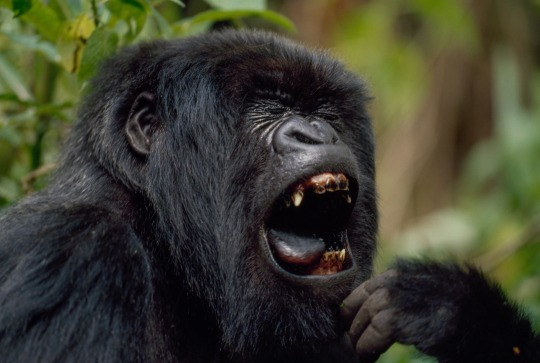
#swingset#mountain gorillas have black-stained mouths because of the high amounts of tanins in their diet#tanins are [some science words i don't understand that basically says they're a special kind of molecule]#they're in coffee and wine and all sorts of things#and apparently the vegetation in the virunga mountains has lots of tannins#and it stains their teeth tongues etc black!#isn't that cool?#primates#primatology#<- in tags
16 notes
·
View notes
Text


JUST IN CASE YOU FELT LIKE SLEEPING TONIGHT -- HEAVY NIGHTMARE FUEL FROM NAMIBIA.
PIC(S) INFO: Spotlight on an olive baboon (genus: Papio anubis) eating the scavenged remains of a young impala, Namibia, Africa. Credits: @chabaporini. 📸: @roymangersnes.
OVERVIEW: "Baboons have an omnivorous diet but are, for the most part, herbivorous. They do, however, eat insects, and will on occasion eat shellfish, trout, salmon and birds, in addition to small antelope and vervet monkeys.
They are even known to steal goats and sheep from human homesteads.
Baboons also occasionally hunt and capture rabbits, baby gazelles or small monkeys
Baboons hunt in small groups to tackle small prey, like lizards or hares, although they are just as often solitary hunters that roam about over a large territory in search of food."
-- IG @bigcatsnamibia, published November 2023
Sources: www.picuki.com/media/2955732492603988756 & Instagram (@bigcatsnamibia page).
#Baboon#Baboons#Mammal#Primate#Africa#Nature#Omnivore#Monkeys#Carnivorous Baboon#African Monkeys#Olive baboon#Papio anubis#Scavenger#Omnivorous#Carnivorous Monkey#African Mammals#African Animals#Animalia#Primates#Omnivorous diet#Nature photography#Nightmare fuel#Carnivorous Baboons#Mammalia#Old World Monkeys#Old World Monkey#Carnivorous Monkeys#Carnivorous#Meat-eater#Carnivore
2 notes
·
View notes
Text
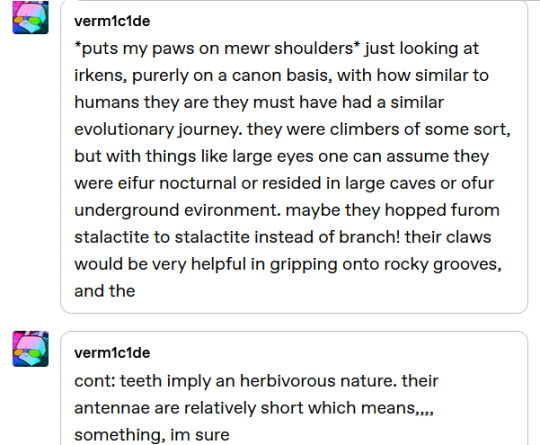
@verm1c1de I ACTUALLY might be able to explain antennae lol so ants use their antennae to "smell" pheromones because their eyesight is actually pretty piss poor for the most part
irkens having shorter antennae could be the result of a few things but i think it could be because of their well developed eyesight...being bipedal or at least not quadruped could also mean they were more visual/tactile in communication rather than basing it on scent
i think very very very early irken ancestors would have had long antennae but as their eyesight developed it just got shorter over time because it was not necessary + gave predators something to grab easily...
#me when i take one animal behavior course#also the aversion to meat it makes sense zim loves sugary sweets because so do ants but they probably had a diet consisting of fruit#im basing it off of ants SORREY but it makes so much sense to me#especially comparing them to humans they would have had to be very social creatures to survive past the early stages#like they r basically humans but if we came from colony insects instead of primates
13 notes
·
View notes
Text
hey google, when & how often do primates - in the wild, if that must be specified - typically eat?
1 note
·
View note
Text

It’s World Orangutan Day! Weighing up to 200 lbs (90.1 kg), the orangutan (genus Pongo) is the largest arboreal animal on the planet! This tree-dweller is also Asia’s only great ape. The critically endangered primate is mostly herbivorous, with a diet that consists of flowers, nuts, and fruit. This species’ historic range in Southeast Asia has shrunk down to just two islands—Borneo and Sumatra—and their population has dipped sharply in the last century. Because they live in lush tropical forests, orangutans are especially vulnerable to deforestation, an ongoing threat as agriculture encroaches on their habitat.
Photo: Eric Kilby, CC BY-SA 2.0, flickr
#science#nature#natural history#animals#fact of the day#did you know#endangered species#orangutan#world orangutan day#animal facts#biodiversity#primates#great apes#mammalogy#conservation#wildlife
450 notes
·
View notes
Text
I may be misunderstanding so correct me if I’m wrong, but I don’t think what you said was OP’s point. Actually I think you’re kind proving what they were saying. Keep in mind that I am not an indigenous persons so if anyone notices that I say something out of line please correct me.
People have supremely screwed over many animal species, that’s true, however what it seems like OP was trying to say was something along the lines of how people are really disconnected from the natural world and the effect that disconnection and lack of understanding (lack of understanding being from those who attack others for using animal products in their culture) has had on indigenous peoples as well as those who work with animals from a cultural standpoint really, really hurts them. Again, that’s just how I read it and Jackal, if you’re reading this, feel free to correct me if I’m wrong.
The issues you brought up don’t really apply to what I think OP was referencing. Many cultures work with animal parts respectfully, and trying to throw in how people have a parasitic relationship with the animals they work with/on really shows that you didn’t get the point at all.
Also ngl it’s kinda fucked up to say people should focus on the “much much more vulnerable communities of non-human animals” when Jackal was literally just talking about how certain people struggle with having their voices heard while trying to advocate for better animal welfare.
I'm not mad I'm just disappointed because if you spent two seconds to think about how fur and leather alone has deep ties to human culture and our understanding and appreciation of the natural world it's honestly really beautiful and just feels so strange to me that people who say they love nature want to divorce themselves from it.
Like yes, capitalism bad. I don't agree with the way that animals are treated as products to the point where blatant animal cruelty is excused by mega corporations. I want places like that to be held accountable and made to follow higher welfare standards for the animals they raise and the underpaid employees out there working in sometimes awful and very unsafe conditions.
But if you're simultaneously ignoring the culture of African leathermaking or the beautiful leather and wool textiles crafted by Indigenous artisans or the ways that ancient humans appreciated the animals they killed for meat and clothing by telling stories and making art depicted on the skins of the animals they took, that's what bothers me.
So many people are willing to just attack vulnerable communities instead of learning about thier culture and how animal products were used traditionally and today. There are better ways to raise animals for products sustainably and humanely and many of these communities have spoken very loudly about it but are yelled over by people who just want to be right or don't want to listen or just don't care.
So yes, I will continue to speak my mind and educate myself because if nothing else I wanna be the start of the change I wanna see in the world. I love animals and I love learning the history of humans and our relationships to animals. I want to be able to appreciate them in the ways we always have. With respect to the natural world and understanding that we're also a part of it.
#I won’t get started on the#‘one can argue that meat is not the default diet for a primate’ bit because you all know my feelings towards that#but it kinda seems like this person proved Jackals point#I have more I could say but I don’t know how to say it#and Jackal please please please let me know if I misinterpreted what you were trying to say!
1K notes
·
View notes
Text
Your regular reminder that wasps are “defensive,” not “aggressive,” since 100% of their fighting instincts are to make sure big mammals stay away from their babies. They want you to see their bright colors and know that they hurt super bad so you won’t be foolish enough to find the nest and eat the larvae, which big mammals have been doing for so long, it’s what selectively bred wasps to be that way to begin with. This does include primates, including humans, in fact bee and wasp larvae have been staple parts of the human diet throughout history and there are still places where specifically types of paper wasp are bred as food!
3K notes
·
View notes
Text
Writing Notes: Why do Humans Like to Drink Alcohol?
Primates have been eating fruit for at least 24 million years.
Most primates, including chimpanzees, orangutans, and gibbons, are primarily frugivorous—fruit is the mainstay of their diet.
The ripest fruits, which are greatly preferred, contain high amounts of two ingredients: sugar and ethanol.
The “ethanol plumes” emitted by fruit might provide cues to its ripeness.
Primates, including humans, have been consuming low levels of ethanol for millions of years through ripe fruit.
Modern humans, however, live in a world that is far removed from this low level of ethanol consumption.
The ethanol levels in fruit are typically only 0.6 percent (Dudley, 2002).
Based on a reasonable set of assumptions, eating ripe fruit might yield a blood ethanol level of only 0.01 percent, far lower than the typical legal definition of drunk, which is typically 0.08 percent.
Our distant ancestors did not have the kegs of beer, bottles of wine, or flasks of whiskey that currently contain high concentrations of alcohol.
According to the frugivory by-product hypothesis, the human penchant for drinking alcohol is not an adaptation but rather is a by-product of adaptive fondness for ripe fruit (Dudley, 2002; Singh, 1985).
Alcohol not only has a distinct taste but it also has a unique odor and is often associated with the color and fragrance of ripe fruits. . . . Utilizing the odor and taste of alcohol enables the animal to predict the caloric value of a food. (Singh, 1985, p. 273)
That is, all humans have adaptations that favor the consumption of ripe fruit, but these can go awry in the modern world of artificial drinks with high alcohol content.
Indeed, alcoholism in the modern world is likely a maladaptive by-product of the overindulgence of these frugivorous adaptations.
The next time you reach for a drink, perhaps you will think of your primate ancestors having their version of a party—sitting around a tree eating ripe fruit.
Source ⚜ More: Writing Notes & References ⚜ Cocktails ⚜ Wine-tasting Writing Resources PDFs
#evolution#writing reference#writeblr#worldbuilding#literature#writers on tumblr#dark academia#spilled ink#writing prompt#creative writing#writing inspiration#writing notes#history#food#writing resources
129 notes
·
View notes
Text
Pseudo-predators
Probably not a real thing but humans are kinda like pseudo-predators. We adapted all these predatory traits before we ever behaviourally became predators.
Examples being:
Forward facing eyes
Starp canines
Pack structures
Probably more that I can’t remember.
Forward facing eyes developed because of us being arboreal. Or…at least from when we used to be arboreal, since it made swinging from branches and jumping between trees much easier since you could tell the distance of the leap and make the decision if the risk of falling would be worth it.
Sharp canines are a shared trait among primates, especially considering toothy bois like gorillas and mandrills have famously large chompers despite being rather strict vegetarians.
Finally pack structures. I guess group structures in general. Group structures aren’t explicitly a predatory trait, but considering our weaker position in the food chain early on, group structures 100% added to our ability to survive.
All together, these traits made it much easier to transition into scavenging and hunting behaviours as opposed to trying to specialise for some kind of plant diet.
#humans are space orcs#primates#pseudo-predators#humans are space oddities#humans are weird#humans are strange
283 notes
·
View notes
Text
Befriending And Working With Crows

Crows have long been associated with witches due to their behavior, mystery, and connection to the supernatural. In folklore, they are seen as messengers between worlds, carrying secrets and omens. Witches were believed to communicate with or shape-shift into crows, using them as familiars to gather information or perform magical tasks. Their black feathers and eerie caws made them symbols of transformation, death, and hidden knowledge. This connection persists in modern witchcraft, where crows are often seen as guides for those practicing divination, shadow work, and spirit communication.
Crows are among the most intelligent birds, possessing problem-solving skills, advanced memory, and the ability to use tools. Studies have shown that they can recognize human faces, plan for the future, and even understand cause and effect. Their complex social structures and ability to communicate information indicate a high level of cognitive function, comparable to that of primates. Crows have been observed crafting tools from leaves and twigs, solving multi-step puzzles, and even holding grudges against perceived threats. Their intelligence makes them highly adaptable and capable of thriving in diverse environments.
Crows are highly intuitive, mysterious, and deeply connected to witchcraft, omens, and spirit work. These birds are known for their symbolism in folklore, association with deities like The Morrigan, Odin, and Hekate, and their ability to form strong bonds with humans. Befriending crows can be a rewarding experience, offering companionship, spiritual messages, and even small “gifts” from the birds themselves. Connecting with the crows isn't hard as they tend to be everywhere and their bravery and curiosity makes them willing to approach certain humans. They have senses of humor, empathy, critical thinking skills, and a lifespan of up to 30 years, all of which makes them excellent companions. Get to know the crows in your neighborhood.
🐦⬛Understanding Crow Behavior
Before approaching crows, it's essential to understand their nature:
• They are highly intelligent – Crows can recognize human faces, solve puzzles, and even speak.
• They have strong social bonds – They communicate within their flocks and even warn each other about potential dangers.
• They can be wary – Earning a crow’s trust takes patience, consistency, and respect.
• They have fantastic memories – A crow won't forget the face of a human that was kind to it and especially not that of one who was rude.
🐦⬛Attracting Crows to Your Space
To encourage crows to visit you regularly, follow these steps:
1. Offer Food Consistently
Crows love high-energy foods. Some of their favorites include:
• Unsalted peanuts (in-shell or shelled) – A crow favorite!
• Sunflower seeds – Nutritious and easy to scatter.
• Fruits (apples, grapes, berries) – Fresh or dried.
• Leftover meat scraps – A natural part of their diet.
• Hard-boiled eggs – A great protein source.

What to Avoid:
• Never feed crows processed, salty, or sugary foods.
• Avoid bread – it lacks nutrition.
• Do not leave large amounts of food – too much can attract unwanted pests.
2. Choose a Safe Feeding Spot
• Select a quiet, open area where they feel comfortable landing.
• Keep a routine – feeding them at the same time each day builds trust.
• If possible, create a dedicated offering space, like a small platform.
3. Provide Fresh Water
• A shallow birdbath or bowl of clean water can help attract crows, especially in dry seasons.
• Change the water frequently to keep it fresh.
🐦⬛Earning Their Trust
1. Observe From a Distance
• At first, let crows come and go without interference.
• Avoid sudden movements or loud noises.
• If they seem cautious, step back and let them approach at their own pace.
2. Speak to Them
• Crows recognize human voices and can distinguish between friendly and hostile tones.
• Greet them softly or whistle a simple tune when feeding them.
• Some witches even give their crows names, reinforcing a bond.
3. Leave Small Offerings
• In addition to food, place shiny objects (small trinkets, marbles, beads) as “gifts” for crows.
• Some crows may return the favor by leaving tokens like buttons, feathers, or shells.
🐦⬛Building a Magickal Relationship
Once crows recognize you as a friend, you can incorporate them into your spiritual practice:
1. Crow as a Spirit Ally
• If a crow visits during ritual work or divination, take note—its presence may carry a message.
• Crows can serve as psychopomps, guiding spirits between realms.
2. Divination & Omens
• A single crow cawing may indicate a warning or message.
• A group (a murder of crows) could symbolize change, transformation, or ancestral spirits.
• Here's some more information about counting crows.
3. Offering a Sacred Space
• Create a small altar outside with natural elements where you place food and gifts.
• Meditate near their space, listening to their calls and energy.
• Put up wards and cast protection magick for the crows.
🐦⬛Strengthening the Bond
• Be patient – Some crows take weeks or months to trust humans.
• Stay consistent – Regular feeding and positive interactions reinforce the bond.
• Respect their autonomy – Crows are wild and should never be captured or forced to interact.

🐦⬛Crow Spells
Crows can assist with your magick as well, through their presence and the lovely black feathers they often leave as gifts or lose through natural shedding. Here are some spells you can do with your crows.
Crow’s Omen Spell (For Divination & Messages)
Needed:
• A quiet outdoor space where crows gather
• A small offering (unsalted nuts, shiny objects, or seeds)
Instructions:
Sit in a place where crows are present and place the offering nearby. Close your eyes and ask the crows for a message:
“Messengers of fate, winged and wise,
Show me the truth with your keen eyes.
A sign, a word, a lesson true,
I call on crows to send their view.”
Observe their behavior. Watch how they move, call, or interact. Their actions may symbolize an answer to your question. Thank the crows and leave the offering as a sign of respect.
Crow’s Wisdom Spell (For Guidance & Insight)
Needed:
• A feather from a crow
• A small black candle
• A piece of paper and a pen
Instructions:
Light the black candle and sit quietly, focusing on a question or situation where you need insight. Hold the crow feather and say:
“Wise crow, keeper of secrets and sight,
Bring me knowledge, clear my mind this night.
Show me the path, help me see,
Reveal the truth and guide me free.”
Meditate for a few moments, then write down any thoughts, visions, or feelings that come to you. Let the candle burn down safely or snuff it out to use again.
Crow’s Shadow Cloak (For Invisibility & Stealth)
Needed:
• A black cloth or scarf
• A crow feather
• A small mirror
Instructions:
Hold the black feather and visualize yourself surrounded by a shadowy aura. Place the mirror face down on the cloth, symbolizing the reflection being hidden. Whisper:
“Dark-winged shadow, silent flight,
Hide me well, keep me from sight.
As the crow vanishes into the night,
Let me fade from every light.”
Wrap the feather in the cloth and carry it when you need to go unnoticed.

Crow’s Omen Spell (For Divination & Answers)
Needed:
• No physical tools, just observation
Instructions:
Find a place where crows are naturally present. Ask your question either aloud or in your mind.
Observe the crows for signs:
• A single crow cawing: A warning or negative response.
• A pair of crows flying together: A positive or cooperative outcome.
• A group of crows circling or gathering: Major change or important news coming.
• A crow bringing or dropping something near you: A strong affirmation or message from the spiritual realm.
Thank the crows for their wisdom.
Crow’s Curse Spell (For Revenge & Justice)
Needed:
• A black feather given by a crow
• A piece of paper with the target’s name
• A dark stone (obsidian, onyx, or jet)
Instructions:
Write the target’s name on the paper and place the crow’s feather over it. Hold the dark stone in your dominant hand and visualize the negative energy returning to its source. Say:
“As the crow flies, swift and free,
Let justice return threefold to thee.
No more harm, no more pain,
What was given, be reclaimed.”
Let the feather sit overnight. The next day, release it into the wind or place it somewhere the crows frequent.
Crow’s Guardian Spell (For Protection & Psychic Defense)
Needed:
• A crow feather
• A small black candle
• A piece of black string
Instructions:
Light the candle and hold the feather. Close your eyes and visualize a crow circling around you, forming a protective barrier. Tie a knot in the black string while chanting:
“Black-winged guardian, fierce and free,
Stand between harm and me.
No ill may pass, no foe may near,
On shadowed wings, keep my path clear.”
Carry the string as a charm of protection, or keep the feather in your home as a spiritual ward.
By observing, working with, and honoring crows, you can create powerful bonds that enhance protection, divination, communication, and justice in your magical practice. If nurtured properly, crows can become lifelong allies, offering wisdom, companionship, and even protection. Treat them well, and they may even become your loyal feathered familiars.

#crow#crows#counting crows#Crow spell#Taming crows#Befriending#companion animals#spirit animal#omens#divination#protection#baneful#wildlife#wild animals#birds#birdwatching#nature#nature witch#familiar#witch#magick#lefthandpath#witchcraft#dark#witchblr#witch community#eclectic witch#eclectic#pagan#animal totems
139 notes
·
View notes
Note
I love that in non-human AU humans are like, rapidly disappearing
So nobody really know what humans like since they’re kinda the template for everyone, like most carnivores assume humans eat just soil and herbivores assume humans eat just bones leftover (based on stereotypes on each other)
Imagine everyone being genuinely worried that they stepping on dirt is like them walking on Yuu’s food or carnivores handing Yuu bones from their leftovers bc they have no idea that humans can eat almost anything (besides raw meat)
(Only the science boys (Trey and Vil) would realize that humans have a very general ability to eat whatever.)
Hmm, kind of but not quite.
There used to be a lot more humans but that war with the fae, despite ending in the human's favor, led to a lot of numbers dwindling. Then after that...well mages only make up a small number of the population, and beastmen are all around stronger with better instincts and can better handle a dangerous magical environment.
Humans...well, although they can survive a great many things, still, slowly and steadily, small numbers become smaller because of this, along with the fact that hybrids' children between beastmen and humans always end with the offspring taking after the beast parent, humans were again becoming less and less.
Small numbers make it pretty difficult to find a mate of your kind that you aren't related to, which leads to more breeding outside of your kind. Then the hybrids that are born from that don't take after their human parent much aside from some less aggressive features and a calmer temperament, which is useful when it comes to more aggressive types of beastmen. Another thing that led to certain kinds of beasts in the past to seek out human mates and help in breeding out some unwanted traits their kind have but not changing them by too much.
Now as for not knowing what humans like...well, many assume that since humans and primate beastmen share common ancestors and certain traits, it means that they like a lot of the same things.
So, as a result of you being a human, you would be more likely to be gifted something like fruit and some bug snacks than..."dirt or bones" from a beastmen since that are just basic known likes for your monkey schoolmates at NRC.
Most primate beastmen see us as a weird kind of distant cousin and find it odd how differently we evolved. No tail or fur and weird flat feet, so much less nimble...poor things.
As for the general diet of beastmen, it's not too different from your basic human diet except certain beastmen prefer certain things. Carnivores can eat vegetables and fruits but prefer mostly meat and can handle raw meat better than others, though it's still recommended that they don't because of parasites. They still of course have the craving for it and it's part of why the cafeteria has meatballs with secret deworming medicine in it. They know the boys are just gonna do what they want.
Deer and bunny beastmen can handle meet just fine but typically stick to a mostly blant-based thing unless they're having a particular craving or need a bit more in their diet to keep healthy.
Admittedly though in general, eating bugs is pretty common among most beastmen but it's usually special ones from the store since eating random ones from outside isn't recommended because, again, parasites...they find it pretty weird if your grossed out by it.
Jamil is happy though that someone else finally understands his dislike for such snacks. If you want something to eat that for sure won't have some kind of bug powder in it for protein or whatever, go to Jamil.
61 notes
·
View notes
Text
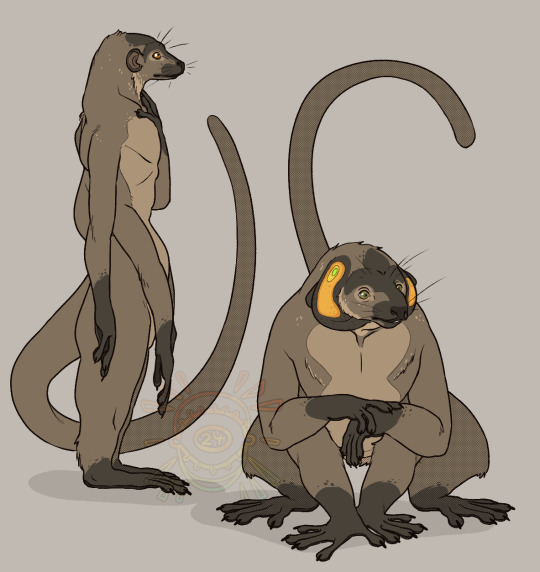

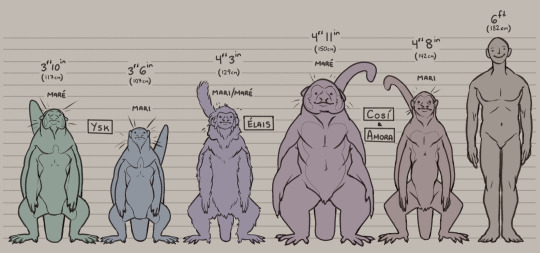

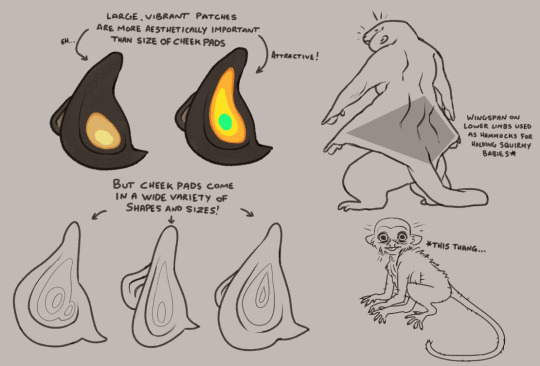
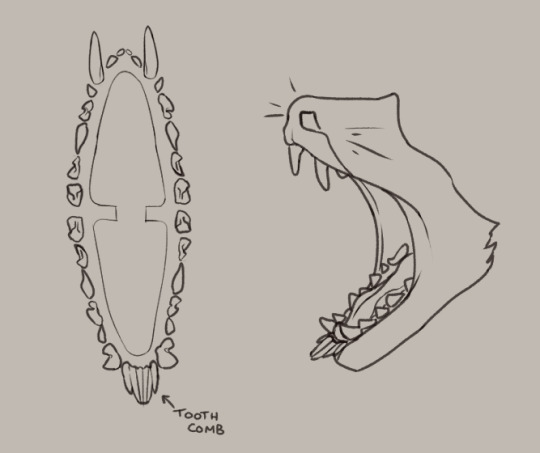
The Marans
Homeplanet: Mara, Frontier Habitat: Varied; dependent on sub-species Lifespan: 60 years Diet: Opportunistic Omnivore
An interesting mix of mustilid and primate, the Marans are a varied group of six-limbed aliens originally from the planet Mara. They are nimble climbers and strong swimmers depending on sub-species, and all generally find greater comfort in walking on four limbs (one set of legs, one set of arms) instead of two. Dislike of being seen as 'animalistic' force more proud Marans to walk on their legs to be seen as equals to their bipedal alien neighbors. Only the Ysk lack a prehensile tail.
More about the Maran subspecies and dimorphism under the cut.
Due to an eighty-year long world war (which has since come to an end), massive displacement and casualties have reduced their numbers drastically. So much so that, evidently, three sub-species are completely lost.
Cosí - the largest surviving pool. Typically found in savannahs, grasslands, and temperate forest zones.
Ysk - the second largest surviving pool. Favors oceanic and coastal zones (tropical, temperate, and polar), but can be found around landlocked lakes and rivers.
Èlais - the smallest surviving pool. Restricted to tundras and taigas (boreal forests).
Amora - only found on the planet of Frontier, and has a smaller pool then Ysk but more then Èlais. Adapted for Frontier's rocky backcountry and temperate shrublands. Speculated to be a mix of Ysk and Cosí lineage due to their large populations on Frontier.
Marans are a two-sex species, and dimorphism is most prominant in the Cosí subspecies. Sexual discrimination is common, with Mari being seen as the superior sex and Marè restricted to more subserviant roles. Referring to Marè as 'female' (due to possessing a uterus) and Mari as 'male' (due to possesing a penis and testicles) is seen as inaccurate and human-centric in the eyes of Marans.
210 notes
·
View notes
Text
thick thighs SAVE LIVES.
when a cis woman is pregnant, her gluteofemoral fat is deposited into her developing baby's brain. fat continues to be deposited during nursing. the less fat deposited, the more the baby's brain development suffers. of all the primates, humans carry the most fat. We are the Fat Primate. We don't just carry fat for day to day support of our large brains, but for the very CREATION of those brains during pregnancy and nursing. long-chain polyunsaturated fatty acids (found in the butt and thigh region) are absolutely crucial for brain development, but they are very hard to come by in our diet, so cis female bodies start depositing them early just in case we want to be making babies later. it's.....humorous to me that so much talk of human evolution either speaks about human exceptionalism in vague terms or cuts out women entirely ("man the hunter" and the overemphasis on male tool use when female primates use tools at greater rates than males, see also our pseudo-scientific belief in a connection between intelligence and maleness when in fact there is no female brain or male brain) when cis female bodies and their cool fucking adaptions are responsible for giving us those large brains we're always bragging about. want to talk about our big brains? then cite your sources! the source in question here being women's body fat.
and then society turns around and goes, let's police women's fat and punish them for it and make them hate themselves so deeply that fatphobia becomes inextricable from our culture - all of this for one of the coolest most metal adaptions of all time that also arguably MADE us human.
fat is the coolest organ in the human body and I will not tolerate the hate.
67 notes
·
View notes
Note
have you heard people talking about primate food intentionally giving manganese poisoning to monkeys to keep them docile? saw it under a vid of someone eating monkey chow
no i haven't seen that, i'm not a nutritionist but it sounds like a massive misunderstanding of the nutrition labels on primate/pet food in general. high manganese proteinate in a diet doesn't cause manganese poisoning in the same way that inhaling manganese from welding fumes does.
71 notes
·
View notes
Note
apologies if this is outside your scope but do you have any advice on making anthro species cuisine reflect the diets of the animal they are based on, while still having the level of depth that human cuisine has?
oh, i love fantasy cuisine as a concept. It might help to research the diet and then also research human foods with similar ingredients, especially if you can find historical dishes from the area those ingredients originated in!
there are some food types that show up in many different cultures, which can serve as a basis for making fantasy foods.
soups!! making broth is as simple as boiling things in water for a really long time, and broth is the basis for pretty much all soups. it's not limited to meat broths! vegetable broth is also a thing that exists. soup just needs Liquid and Food Chunks. it's very easy.
bread! there are so many different forms of bread in so many cultures. wheat, rye, millet, corn, almond; pretty much any grain or nut (and even other things!) can be turned into flour, and that can be made into some form of "bread" depending on how far you stretch the definition of bread. tortillas, naan, rolls, biscuits, dumplings, etc etc. pan fried, oil fried, baked, boiled, whatever. yeast not required.
alcohol. honestly, one of the most common things in the world. wild animals get inebriated from eating fermented fruit all the time. they could most certainly make alcohol if they were sapient enough to do it on purpose.
preserved foods! pickled things, jams, jerky, fermentation, etc. finding ways to keep food safe for long periods or time is very important in pretty much every culture, and some foods require long term preservation methods to become edible in the first place, like fermented shark.
herbs and spices! number one way to make food more interesting. salt is a bare minimum: a lot of animals seek out salt as a dietary supplement! though your non-primate people species may not be able to eat things like garlic and spicy peppers (since they tend to make most animals sick) there will probably be other flavorful herbs and spices they can add to their food.
I hope that's helpful for you! good luck!
130 notes
·
View notes